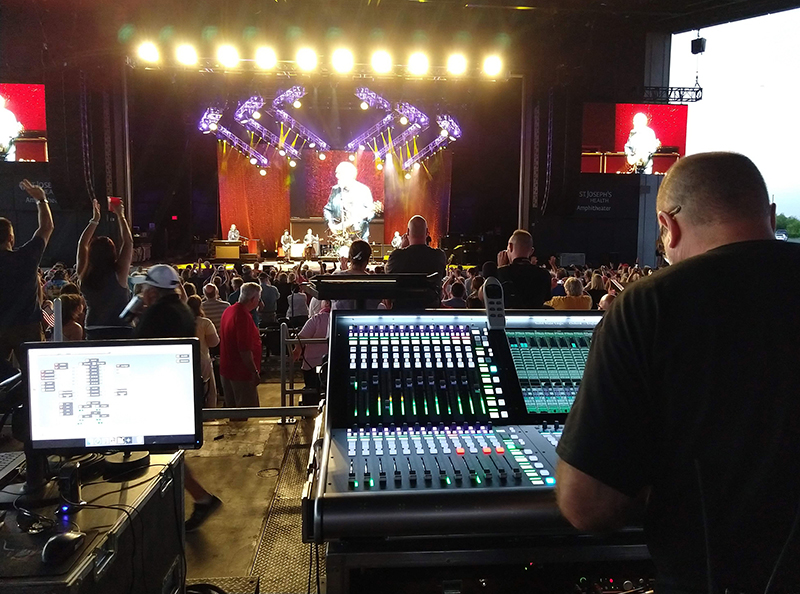The question this time out: How do you handle large channel counts (i.e., DCA/groups/channel banks)?
Karrie Keyes (monitors): We just finished rehearsals for a tour (before it was postponed) and we were well over 100 channels for a six-member band. I stopped counting at some point. Several of my channels are duplicates to suit the needs of different band members, i.e., one wants the kick drum “clicky,” another doesn’t want any high end, etc. Also, some are for cues, so I can ride solos or they’re needed for intros, etc.
Anyone who follows Pearl Jam knows that the setlist is dynamic and is never the same from night to night, and there are well over 100 songs to choose from; in addition, the setlist can and does change during the show, so I do use snapshots. I could dig myself into a hole fairly fast if I was using them, so I rely on my fader banks. I work on a DiGiCo SD5 so I can get around my channels pretty easily, setting them up to have everything I need at all times on the surface. My left fader banks are most of my cues and my right banks are my singer and his inputs.
Then I start to group the rest of the channels by band member, so all of Stone’s inputs get a bank, and so on. No one really has a whole band mix so this works well. I’m also fortunate that mixes (around 40) are consistent, rarely changing drastically during the show. The main thing for me is to be able to watch the band and be able to mix without my head in a screen, be able to access my inputs quickly and getting things committed to muscle memory.
Christopher Grimshaw (FOH): It’s rare that I have to deal with really large channel counts – I try to keep my setups as sane as possible in order to avoid these headaches! That said, if I’m in a situation where I’ll be dealing with lots of channels, I do the following: Make the channel list as logical as possible. For me at FOH, the order will be similar to how I see things on-stage: vocals 1-5 will be from my left to right, for example. That means it’s quick and easy to dive into the channel banks and grab something. I don’t mind skipping channels to keep things grouped nicely, either. If the desk I’m working on gives me 16x faders at a time and 1-13 are taken up with vocals and some instruments, I’ll start the drums on Ch17 so they’re all on one set of faders when I come to work on the drum mix.
Assign DCAs and etc. ahead of time, including FX! If I have to condense it down to 8x faders to mix on, it’ll be something like Lead Vocal, Background Vocals, Guitars, Keys, Bass, Drums, Vocal Reverb, and Drum Reverb. Of course, that depends on the act. I spend most of the gig mixing from the DCAs, but if there’s something particular that needs work, I’ve still got my sensibly arranged channel faders to fall back on. I spent a lot of my formative sound-engineering years mixing traditional folk bands, where vocals always came first, and that’s something I’ve stuck with: My first DCA is always Lead Vox, and the second is always Backing Vox. They’re the faders that I want to be able to grab first.
I occasionally use subgroups to process a few similar inputs. For example, a bit of fast compression on the overall drum mix can help reign in a drummer that’s suddenly hitting 10 dB harder. With the amount of processing available on modern digital mixers, though, there’s enough processing at the channel level that I rarely need the extra processing at the group stage. On a similar note, though, putting all the backing vocals through a compressed subgroup can keep them from overwhelming the lead singer, while if only one or two of the backing singers have a part, the compressor will allow a bit more level through. It’s not quite auto-mixing, but it’s just a way of getting the desk to keep an eye on things for me.
In conclusion, keep it logical, and plan ahead. Figure out the sort of adjustments you’re likely to want to make to your mix and set your groups and DCAs accordingly.
Michelle Pettinato (FOH): When mixing an act with a large channel count on a digital console where there are a limited number of faders available on the surface, I put a lot of thought into my workflow and how I want my inputs to populate the surface. It’s all about control and efficiency. I group things together in ways that I have as much control over things with the fewest number of faders and banks/layer moves.
I always make use of DCAs and sometimes groups no matter what the channel count. Typical breakdown is DCA for Drums, Bass, Guitars, Keys, Band, FX, Vocal FX, Background Vocals, and Lead Vocal. I like to mix from DCAs and build them so that each musician has their own dedicated DCA with all of their instruments. This way I have control over each musician’s inputs with one fader. I like to assign all of the instruments and tracks, to one additional Band DCA; reason being, if I find the vocal is getting lost under the music I can bring the entire band down easily with one fader while preserving the balance between the individual instruments.















